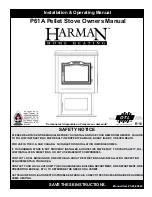
11
LOCATION
There are several conditions to be considered in
selecting a location for your Stanley Lismore Stove.
a.
Position in the area to be heated, central
locations are usually best.
b.
Allowances for proper clearances to
combustibles.
c.
Allowances for proper clearances for mainte-
nance work.
CLEARANCE TO COMBUSTIBLES
Maintain at least the following clearances to all
combustible material:
From the front
460 mm (18”)
From the back
200 mm (8”)
From the sides
150 mm (6”)
From the flue pipe
460 mm (18”)
straight up only
It is recommended that the appliance is sited next to
and on a non-combustible surface. A minimum all
round clearance of 150mm will allow air circulation
and will not impeed the performance of the stove.
Fig.7
PLUMBING
FLOOR PROTECTION
When installing this heater on a combustible floor, a
floor protector consisting of a layer of non com-
bustible material at least 310mm thick covered with
“1/8 sheet metal” is required to cover the area under
the heater and extend at least 460mm at the front,
150mm to the side & 200mm from the rear. This will
provide protection from sparks and embers which
may fall out from the door when stoking on refu-
elling. See Fig.7.
REGULATIONS
The plumbing must be in accordance with all
relevant regulations and practices. It must include a
gravity circuit with expansion pipe, open to the
atmosphere. The central heating will normally be
pump-driven as with other types of boilers.
PIPE THERMOSTAT
The fitting of a pipe thermostat to the flow pipe is
essential in order to activate the water circulation
pump when the water reaches the selected
temperature.
When the water temperature falls below the select-
ed temperature the pipe thermostat will cut off the
water circulation pump in order to allow the boiler to
recover.
Fig.8
GRAVITY CIRCUIT
The gravity circuit consists of the domestic hot water
tank of 135 litres indirect cylinder, fixed in an upright
position, recommended for hot water storage and it
should be connected to the boiler by 28mm diame-
ter flow and return piping. The pipes should not
exceed 7.8 meters (25ft) in length and cylinder and
pipework should be fully lagged. The shorter the run
of pipe work the more effective the water heating.
There must be no gate valves on this circuit and it
must have an expansion pipe exhausting to
atmosphere. Cylinder and pipe work should be
lagged to minimise heat loss.
Fig. 9 illustrates the basic principal of water heating
systems and must not be regarded as a working
drawing.










































